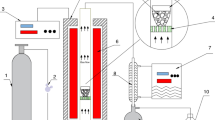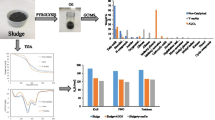Abstract
Thermal analysis of oily sludge (OS) from steel mills was conducted to understand its added value. The effect of additional catalysts (calcined olivine (C-OL), iddingsite (C-ID), xiuyan jade (C-XY), and their nickel carrier on OS pyrolysis performance was also investigated. The physical properties of OS showed a large number of resins and irons. It was found that OS pyrolysis involves water evaporation, light hydrocarbon escape, the crack of resins, asphaltene decomposition, and inorganic mineral decomposition. TG results demonstrated that the prepared catalyst can effectively improve the weight loss, in which the C-OL (Ni) increased by 11.58 wt.%. The kinetic behavior of the three main weight loss zones in the catalytic pyrolysis of OS was subsequently analyzed. The apparent activation energies of the main stages of OS pyrolysis were 61.03, 18.07, and 62.92 kJ/mol, respectively. The addition of C-OL significantly reduced the apparent activation energies by 31.34, 5.74, and 44.46 kJ/mol. The evaluation of the pre-exponential factor revealed that all stages of OS pyrolysis followed a diffusion model, and the reaction path was not changed by the ore catalysts.



Similar content being viewed by others
References
Jin X, Teng D, Fang J et al (2021) Petroleum oil and products recovery from oily sludge: characterization and analysis of pyrolysis products. Environ Res 202:111675. https://doi.org/10.1016/j.envres.2021.111675
Zhang L, Tong K, Wang X et al (2015) Research progress of ultrasonic technology for oil sludge treatment. Environ Protect Oil Gas Fields (in Chinese) 25:73-76+87
Song Q, Zhao H, Jia J et al (2019) Characterization of the products obtained by pyrolysis of oil sludge with steel slag in a continuous pyrolysis-magnetic separation reactor. Fuel 255:115711. https://doi.org/10.1016/j.fuel.2019.115711
Huang Q, Han X, Mao F et al (2014) A model for predicting solid particle behavior in petroleum sludge during centrifugation. Fuel 117:95–102. https://doi.org/10.1016/j.fuel.2013.09.002
Karamalidis AK, Voudrias EA (2007) Release of Zn, Ni, Cu, SO42− and CrO42− as a function of pH from cement-based stabilized/solidified refinery oily sludge and ash from incineration of oily sludge. J Hazardous Mater 141:591–606. https://doi.org/10.1016/j.jhazmat.2006.07.034
Wang Z, Guo Q, Liu X, Cao C (2007) Low temperature pyrolysis characteristics of oil sludge under various heating conditions. Energy Fuels 21:957–962. https://doi.org/10.1021/ef060628g
Gao N, Li J, Quan C, Tan H (2020) Product property and environmental risk assessment of heavy metals during pyrolysis of oily sludge with fly ash additive. Fuel 266:117090. https://doi.org/10.1016/j.fuel.2020.117090
Kan T, Strezov V, Evans TJ (2016) Lignocellulosic biomass pyrolysis: a review of product properties and effects of pyrolysis parameters. Renew Sustain Energy Rev 57:1126–1140. https://doi.org/10.1016/j.rser.2015.12.185
Fahmy TYA, Fahmy Y, Mobarak F et al (2020) Biomass pyrolysis: past, present, and future. Environ Dev Sustain 22:17–32. https://doi.org/10.1007/s10668-018-0200-5
Hu X, Gholizadeh M (2019) Biomass pyrolysis: a review of the process development and challenges from initial researches up to the commercialisation stage. J Energy Chem 39:109–143. https://doi.org/10.1016/j.jechem.2019.01.024
Lin B, Huang Q, Chi Y (2018) Co-pyrolysis of oily sludge and rice husk for improving pyrolysis oil quality. Fuel Processing Technol 177:275–282. https://doi.org/10.1016/j.fuproc.2018.05.002
S C, Y W, N G, et al (2016) Pyrolysis of oil sludge with oil sludge ash additive employing a stirred tank reactor. Journal of Analytical and Applied Pyrolysis 120:511 520 https://doi.org/10.1016/j.jaap.2016.06.024
Shie J-L, Lin J-P, Chang C-Y et al (2003) Pyrolysis of oil sludge with additives of sodium and potassium compounds. Resour Conserv Recycl 39:51–64. https://doi.org/10.1016/S0921-3449(02)00120-9
Heng Q, Huang S, Lou W et al (2021) Study on the difference between in-situ and ex-situ catalytic pyrolysis of oily sludge. Environ Sci Pollut Res 28:50500–50509. https://doi.org/10.1007/s11356-021-14233-6
Lin B, Wang J, Huang Q, Chi Y (2017) Effects of potassium hydroxide on the catalytic pyrolysis of oily sludge for high-quality oil product. Fuel 200:124–133. https://doi.org/10.1016/j.fuel.2017.03.065
Hou J, Zhong D, Liu W (2022) Catalytic co-pyrolysis of oil sludge and biomass over ZSM-5 for production of aromatic platform chemicals. Chemosphere 291:132912. https://doi.org/10.1016/j.chemosphere.2021.132912
Wang F, Zhang H, Du M et al (2021) Effects of TiO2/bentonite on the pyrolysis process of oily sludge. Nat Environ Pollut Technol 20:1–12
Wang Q, Hao K, Benally C et al (2022) The role and potential of attapulgite in catalytic pyrolysis of refinery waste activated sludge. Pet Sci 19:354–362. https://doi.org/10.1016/j.petsci.2021.09.043
Gong Z, Zhang H, Liu C et al (2021) Co-pyrolysis characteristics and kinetic analysis of oil sludge with different additives. J Therm Sci 30:1452–1467. https://doi.org/10.1007/s11630-021-1421-8
Lu C, Zhang X, Gao Y et al (2021) Parametric study of catalytic co-gasification of cotton stalk and aqueous phase from wheat straw using hydrothermal carbonation. Energy 216:119266. https://doi.org/10.1016/j.energy.2020.119266
Zhang X, Xu J, Ran S et al (2022) Experimental study on catalytic pyrolysis of oily sludge for H2 production under new nickel-ore-based catalysts. Energy 249:123675. https://doi.org/10.1016/j.energy.2022.123675
Yang J, Xu X, Liang S et al (2018) Enhanced hydrogen production in catalytic pyrolysis of sewage sludge by red mud: thermogravimetric kinetic analysis and pyrolysis characteristics. Int J Hydrog Energy 43:7795–7807. https://doi.org/10.1016/j.ijhydene.2018.03.018
Ma X, Zhao X, Gu J, Shi J (2019) Co-gasification of coal and biomass blends using dolomite and olivine as catalysts. Renew Energy 132:509–514. https://doi.org/10.1016/j.renene.2018.07.077
Tursun Y, Xu S, Abulikemu A, Dilinuer T (2019) Biomass gasification for hydrogen rich gas in a decoupled triple bed gasifier with olivine and NiO/olivine. Bioresour Technol 272:241–248
Yao D, Yang H, Chen H, Williams PT (2018) Investigation of nickel-impregnated zeolite catalysts for hydrogen/syngas production from the catalytic reforming of waste polyethylene. Appl Catal B 227:477–487. https://doi.org/10.1016/j.apcatb.2018.01.050
Vyazovkin S (2002) Thermal analysis. Anal Chem 74:2749–2762. https://doi.org/10.1021/ac020219r
Pinzi S, Buratti C, Bartocci P et al (2020) A simplified method for kinetic modeling of coffee silver skin pyrolysis by coupling pseudo-components peaks deconvolution analysis and model free-isoconversional methods. Fuel 278:118260. https://doi.org/10.1016/j.fuel.2020.118260
Mishra RK, Mohanty K (2018) Pyrolysis kinetics and thermal behavior of waste sawdust biomass using thermogravimetric analysis. Bioresour Technol 251:63–74. https://doi.org/10.1016/j.biortech.2017.12.029
Mian I, Li X, Jian Y et al (2019) Kinetic study of biomass pellet pyrolysis by using distributed activation energy model and Coats Redfern methods and their comparison. Bioresour Technol 294:122099. https://doi.org/10.1016/j.biortech.2019.122099
Subramanian S, Ragula UBR (2020) Kinetics of catalytic and non-catalytic pyrolysis of Nerium oleander. Fuel 280:118591. https://doi.org/10.1016/j.fuel.2020.118591
Vyazovkin S, Burnham AK, Favergeon L et al (2020) ICTAC Kinetics Committee recommendations for analysis of multi-step kinetics. Thermochimica Acta 689:178597. https://doi.org/10.1016/j.tca.2020.178597
Trejo F, Rana MS, Ancheyta J (2010) Thermogravimetric determination of coke from asphaltenes, resins and sediments and coking kinetics of heavy crude asphaltenes. Catalysis Today 150:272–278. https://doi.org/10.1016/j.cattod.2009.07.091
Sadhukhan AK, Gupta P, Saha RK (2009) Modelling of pyrolysis of large wood particles. Bioresour Technol 100:3134–3139. https://doi.org/10.1016/j.biortech.2009.01.007
Coats AW, Redfern JP (1964) Kinetic parameters from thermogravimetric data. Nature 201:68–69. https://doi.org/10.1038/201068a0
Alves JLF, da Silva JCG, Mumbach GD et al (2022) Prospection of catole coconut (Syagrus cearensis) as a new bioenergy feedstock: insights from physicochemical characterization, pyrolysis kinetics, and thermodynamics parameters. Renew Energy 181:207–218. https://doi.org/10.1016/j.renene.2021.09.053
Spiecker PM, Gawrys KL, Trail CB, Kilpatrick PK (2003) Effects of petroleum resins on asphaltene aggregation and water-in-oil emulsion formation. Colloids Surf A: Physicochem and Eng Aspects 220:9–27. https://doi.org/10.1016/S0927-7757(03)00079-7
Moncayo-Riascos I, Taborda E, Hoyos BA et al (2020) Effect of resin/asphaltene ratio on the rheological behavior of asphaltene solutions in a de-asphalted oil and p-xylene: a theoretical–experimental approach. J Mol Liq 315:113754. https://doi.org/10.1016/j.molliq.2020.113754
Schorling P-C, Kessel DG, Rahimian I (1999) Influence of the crude oil resin/asphaltene ratio on the stability of oil/water emulsions. Colloids Surf A: Physicochem Eng Aspects 152:95–102. https://doi.org/10.1016/S0927-7757(98)00686-4
Gupta GK, Mondal MK (2019) Kinetics and thermodynamic analysis of maize cob pyrolysis for its bioenergy potential using thermogravimetric analyzer. J Therm Anal Calorim 137:1431–1441. https://doi.org/10.1007/s10973-019-08053-7
Badshah SL, Shah Z, Alves JLF et al (2021) Kinetic and thermodynamics study of the pyrolytic process of the freshwater macroalga, Chara vulgaris. J Appl Phycol 33:2511–2521. https://doi.org/10.1007/s10811-021-02459-3
Funding
This work was supported by the Natural Science Foundation of Jiangsu Province (BK20201365); Jiangsu Key Laboratory of Process Enhancement and New Energy Equipment Technology; the Top-notch Academic Program Project of Jiangsu Higher Education Institutions; Natural Science Foundation of the Jiangsu Higher Education Institutions of China (19KJB610001).
Author information
Authors and Affiliations
Contributions
Jiayu Xu: conceptualization, investigation, writing original draft. Longyuan Yang: validation, writing–review and editing. Hui Xu: supervision, resources. Yue Jiang: visualization, formal analysis. Yuan Guo: formal analysis. Shuai Ran: visualization. Ying Gao: conceptualization, writing–review and editing, supervision, funding acquisition.
Corresponding author
Ethics declarations
Competing interests
The authors declare no competing interests.
Additional information
Publisher's note
Springer Nature remains neutral with regard to jurisdictional claims in published maps and institutional affiliations.
Supplementary Information
Below is the link to the electronic supplementary material.
Rights and permissions
About this article
Cite this article
Xu, J., Yang, L., Xu, H. et al. Characteristics and kinetic analysis of the catalytic pyrolysis of oily sludge under new nickel-ore–based catalysts. Biomass Conv. Bioref. 14, 10421–10429 (2024). https://doi.org/10.1007/s13399-022-03069-w
Received:
Revised:
Accepted:
Published:
Issue Date:
DOI: https://doi.org/10.1007/s13399-022-03069-w




